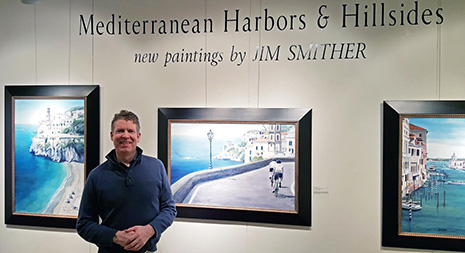Wilder School Spotlight
Meet Jim Smither

By Pamela Stallsmith
Jim Smither explains himself visually.
As an instructor in the Wilder School’s Urban and Regional Studies/Planning program, Smither blends his skills as a fine artist, landscape architect, urban planner and urban designer to teach the broad principles of illustration and design in the study of place.
“Art and teaching go really well together,” he explained. “They’re symbiotic. Urban planning allows me to use my art skills to tell the story of place and explain what a place means to people. It can be done in the written word, but my expertise is in the visual.”
Jim Smither’s current exhibit
“Mediterranean Harbors and Hillsides”
Through March 6
Crossroads Art Center
2016 Staples Mill Rd.
Richmond, Va. 23230
He also views himself as a geographer. “Everything I do is about designing a place, painting a place, analyzing a place, teaching about a place or helping the class visualize a new place Geography to me is the study of place.”
Smither, who grew up in Richmond, brings to the classroom more than 25 years of experience in urban planning and art. He joined Virginia Commonwealth University in the fall of 2010, teaching students the skills of design, planning, visualization and graphics.
In a photography course at Roanoke College, where his earned his bachelor’s in urban studies, he learned to explore places. At first he considered photography more of a science, but soon appreciated it as a form of art.
“It’s not just about how the shutter speed works or the setting of the aperture. I realized it was an art form because it has to do with capturing a mood that can be experienced through a composition. It might be figures interacting with each other or with their environment, such as a building or a landscape. It also has to do with color and tonal values that you experience at different times of the day.”
He applies those theories to his paintings. “One of the most important part to convey in a painting is the sense of space, of cutting the allusion of a two-dimensional surface.” His practical experience complements his three advanced degrees. While studying for his master’s degree in landscape architecture at the University of Virginia, he was required to draw places, depicting them and proposing a purpose. He also earned a master’s in urban and regional planning from George Washington University, as well as a Master of Urban Design from the University of Melbourne in Australia.
Then he began thinking “about art for art’s sake,” and started painting. He’s owned a small business, Smither Design, since the late 1990s and founded Jim Smither Fine Art in 2007.
He currently has a solo show on display through March 6 at Crossroads Art Center in Richmond, “Mediterranean Harbors and Hillsides.” The show explores “undulating landscape, breathtaking sea views and layers of cultural history” throughout Italy, paintings based on on-site studies conducted in May-June 2015. This is his second solo show, and he’s been part of 15 group shows at Crossroads, Art Works in Richmond and Gallery Flux in Ashland.
His interest in geography has taken him throughout the world, across North America, Europe, New Zealand, Australia and Asia.
“When I go to places, I am looking for an experience. I’m primarily visual in nature. I’m looking for what a place means to people, how people live in them, how they interact, how they use them and what the problems are,” he said, such as a town plaza or city center.
Smither started teaching at VCU after meeting Mort Gulak, the longtime professor who helped found the MURP program, who encouraged him to join the faculty.
His classes cover the themes of the theory, practice and skills of urban design at both the undergraduate and graduate level. He challenges his students to look at the intention of design, its practical aspects and how to best depict design concepts, whether through photography, 3-D renderings by hand or computer-aided programs.
“If you want to be good at design, you have to practice designing,” he said. “With theory, you need to read the books and attend the lectures. And you need to go into the world and learn things, test things for yourself,” he said.
What makes the Wilder School’s urban and regional planning program unique is its focus on experiential learning.
Last year, his graduate studio class created a neighborhood and historic preservation plan for the City Point section of Hopewell, which the City Council eventually endorsed. The plan includes streetscape improvements such as interpretative signage, new street signs and a community garden.
“In the urban and regional studies program, one foot is in practice and one foot is in academics — that’s what makes our program special,” he said. “In the three master’s program in which I was enrolled, I never did one real-world project where I produced a plan for someone.
“What we do at the Wilder School is a win-win for students and the community — the students gain practical experience, and the community gains something of value.”